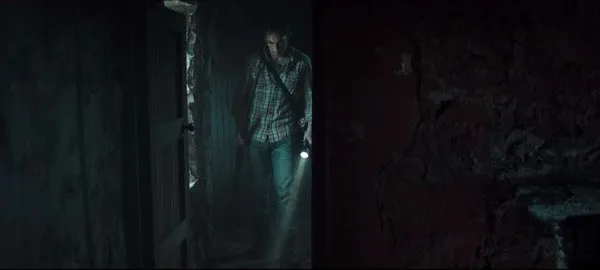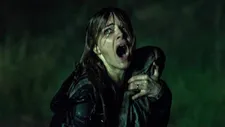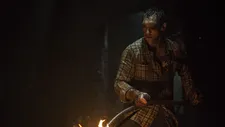 |
| What lurks in dark places? |
It’s probably fitting that the bar that I’m meeting Corin Hardy in a hotel lined with eerie photographs dating back to the Fifties, each looking like the final shot of The Shining. Whilst waiting for him to finish up with another journalist, I scan them. hoping to see the leering face of Jack Torrance. It would be fitting, because Hardy is a man who clearly has a reverence for good, horror films, but I don’t see him. Which is probably for the best, because I’m here to do an interview, not get trapped in a labyrinth of impossible corridors.
When he’s ready, we’re ushered away from the quiet majesty of the upper rooms into a noisy bar, but Corin looks more at home here anyway. He’s got rockstar hair and a Misfits tee, so its no surprise that he’s big into horror, and currently directing a remake of the cult goth classic, The Crow. Having seen his current creature feature The Hallow just the day before, I tell him how enthusiastic I was too have seen an animatronic supervisor credited in the first few seconds of the film, and ask him about his decision to use practical effects, and the difficulties of such an undertaking.
"I grew up loving what I consider to be the best horror movies out there, Alien, The Thing, The Fly, and The Evil Dead," he says. "These were movies made before CGI was involved, and there’s something about them because you couldn’t rely on CGI to tell a story. As an artist, I studied sculpture, illustration, animation, make-up, and when making The Hallow I believed they were techniques that were still totally relevant, but now there’s the bonus of being able to use CG to augment them."
It’s worth noting that The Hallow features some truly exceptional special effects work, whilst still managing to go toe-to-toe with the modern day big budget CGI blockbusters, and it’s Hardy’s open-minded and thorough approach that make this the case. Before carrying on, he lets me take a flick through the making-of book that he’s brought with him, which is full of sketches, photos of moulds and prosthetics...
 |
| Alone in the dark |
"It wasn’t a case of do you use CGI or practical, it’s a case of 'I want to use all the tools out there to create an illusion that’s difficult to pin down, but it feels real,' and to me it was, or at least I hope it was successful. I tried to do everything as practical as possible, using traditional techniques such as a man in a suit, or puppetry. With those you get more connected to what’s on screen, more scared. But I was using CG and VFX to do invisible work, take out wires, add depth to a hole that can’t be that deep. Not only do you not feel as connected to CG creatures, but to do it well, as well as I wanted to do it, is just too expensive. It might have been easier in some ways, because it means a lot of prep in pre-production; sculpts, taking casts. You can’t just clean up in post, and these considerations are challenges for a low budget independent movie."
Part of the reason the physical effects are so successful is due to interaction between the creatures and the tactile nature of the settings, but it isn’t without its challenges.
"No, absolutely. I love all the challenge because I think if you push through difficulties, you come out the other side with something that’s more special. To have the creatures and props affected by the mud, rain, smoke, to shoot it in camera, you get things that you lose by simply adding everything in post. I wanted to tell a fairy tale in a gritty, grounded way that didn’t feel too fantastical or magical. I wanted the fairy tale elements to creep in gradually, and trying to do everything in camera in real grimy locations was one of the ways I looked to achieve this."
As he previously mentioned The Fly and The Evil Dead, I ask about his approach to the construction of the reality of the film, the quasi-sci fi elements and the hints of a rational explanation.
"I wanted to create enough information in the setup and suggestion as to what’s about to happen, that you could believe in it. I don’t think you have to have everything explained to you in a movie. Obviously I have my own reasons and thoughts behind the events, but I wanted to play with superstition, mythology, biology and nature’s revenge, to bring them together. There are the locals in the film, who believe it’s real, part of their folklore. Whereas Adam is a rational man who believe it’s something biological. My idea is that it’s essentially both."
 |
| Keeping the fire going |
The reasoning and pathos behind the creatures in The Hallow cannot be understated. They feel like they have purpose, and aren't just dropped as a device to scare the characters. Although the creatures display animalistic drive, beyond the comprehension of human reasoning. It brought to my mind the reasoning behind the ghosts in 1982’s Poltergeist, the reverence and contemplation about the spirit world is, to me, something that feels lacking in modern horror. I asked Corin if he felt the same, and if he believed that modern horror didn’t care why their worlds existed, that they were just nasty for the purposes of providing people with a way to pay to be scared.
"I’d agree with the last bit, definitely. It’s an interesting question which ultimately comes down to how you want to tell your story; what are the rules? Are you gonna obey them or are you gonna betray your story? Whether a movie is horror or not, I want it to be honest to itself - whatever the genre - I want it to follow through. That’s what I tried to do with The Hallow, to just tell a story that’s relatively simple and familiar, but to create limitations within it and then push to the extremes of those limitations without betraying the story. I think you can break rules though, but only if you know you’re doing it, and there’s a reason.
"I like a lot of crappy horror movies because they’re enjoyable. I set out to make a film that was fun, with a story that made sense, but didn’t ram it all in your face. There’s an imagination beyond the movie: the casting of the actors, the effects work, the choice of locations, cinematography, and sound design. I was just trying to create something immersive and enjoyable entertainment.
"It was tough, there’s a balance, especially in horror, where you want to show enough to be scary but restrained enough to keep the mystery there. If you don’t show enough, people feel cheated, and if you show too much they feel underwhelmed. Also, when you’re talking showing it off, it’s like editing: you can do five amazing takes, but you can only use one. if you want to remain true to the story, sometimes you can’t use something."
The Hallow is definitely enjoyable, and it’s not lacking in immersion either. The creatures never feel like they’re restrained by budget, or because of limitations of the quality of the effects. It’s steeped in grizzly, gooey prosthetics and animatronics, it has a sensibility that seems lacking in modern horror, with only Neil Marshall’s The Descent really bringing to mind the same kind reverence for a well shot man in a suit being scarier than any amount of CGI. In the second half of this interview, Corin gets in depth on the influences and ideas behind The Hallow.





















